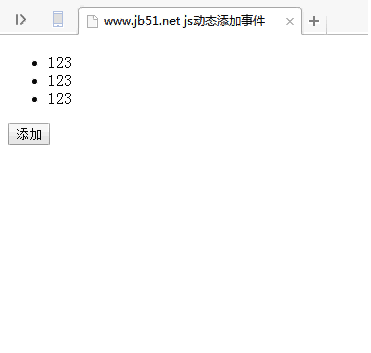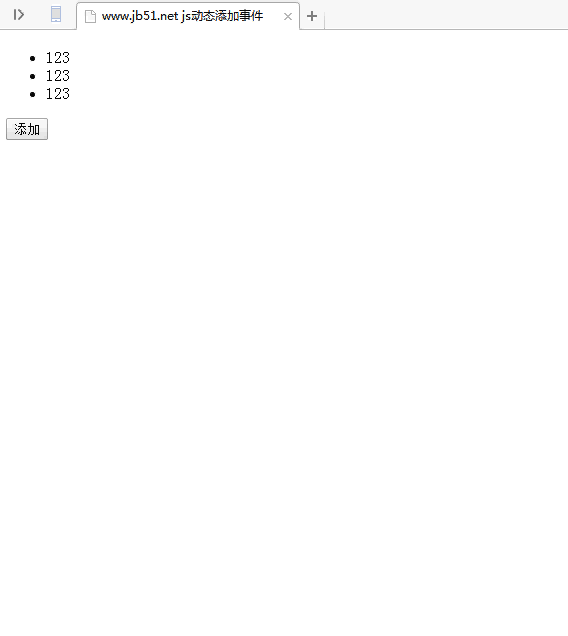 Web Front-end
Web Front-end
 JS Tutorial
JS Tutorial
 JS implementation example of adding event function to dynamically added elements
JS implementation example of adding event function to dynamically added elements
JS implementation example of adding event function to dynamically added elements
This article mainly introduces the JS implementation of adding events to dynamically added elements, and analyzes the related operation skills of javascript based on event delegation to add events to dynamically added elements. Friends who need it can refer to it
The example of this article describes the JS implementation of adding event functions to dynamically added elements. Share it with everyone for your reference, the details are as follows:
We sometimes create some elements through js in daily development, but if you use the original for loop to add events to the created nodes, it often does not work:
<!DOCTYPE html>
<html lang="en">
<head>
<meta charset="UTF-8">
<title>www.jb51.net js动态添加事件</title>
</head>
<body>
<ul id="out-ul">
<li class="out-li">123</li>
<li class="out-li">123</li>
<li class="out-li">123</li>
</ul>
<button id="btn">添加</button>
<script>
document.getElementById('btn').addEventListener('click',function(){
var htmlFragment='<li>我是新增的li</li>';
var addLi=document.createElement('li');
addLi.innerHTML=htmlFragment;
outUl.appendChild(addLi);
},false);
var outUl=document.getElementById('out-ul')
var outLi=outUl.getElementsByClassName('out-li');
for(var i=0;i<outLi.length;i++){
outLi[i].onclick=function(){
alert(1);
}
}
</script>
</body>
</html>Operation effect:

For example, the events added to li through the for loop cannot be bound to The detailed reasons for the newly added li will not be explained here. So how to solve this? In fact, the solution is simple, that is, to solve it through event delegation, directly enter the code, the above code is simply modified:
<!DOCTYPE html>
<html lang="en">
<head>
<meta charset="UTF-8">
<title>www.jb51.net js动态添加事件</title>
</head>
<body>
<ul id="out-ul">
<li class="out-li">123</li>
<li class="out-li">123</li>
<li class="out-li">123</li>
</ul>
<button id="btn">添加</button>
<script>
var outUl=document.getElementById('out-ul')
var outLi=outUl.getElementsByClassName('out-li');
document.getElementById('btn').addEventListener('click',function(){
var htmlFragment='<li>我是新增的li</li>';
var addLi=document.createElement('li');
addLi.innerHTML=htmlFragment;
outUl.appendChild(addLi);
},false);
outUl.addEventListener('click',function(e){
e=e || window.event;//兼容ie
alert(e.target.innerHTML);
}, false);
</script>
</body>
</html>Run Effect:

The above is what I compiled for everyone. I hope it will be helpful to everyone in the future.
Related articles:
Ajax Gets data through city name
Ajax form verification after MVC meets bootstrap
AJAX request queue implementation
The above is the detailed content of JS implementation example of adding event function to dynamically added elements. For more information, please follow other related articles on the PHP Chinese website!

Hot AI Tools

Undresser.AI Undress
AI-powered app for creating realistic nude photos

AI Clothes Remover
Online AI tool for removing clothes from photos.

Undress AI Tool
Undress images for free

Clothoff.io
AI clothes remover

Video Face Swap
Swap faces in any video effortlessly with our completely free AI face swap tool!

Hot Article

Hot Tools

Notepad++7.3.1
Easy-to-use and free code editor

SublimeText3 Chinese version
Chinese version, very easy to use

Zend Studio 13.0.1
Powerful PHP integrated development environment

Dreamweaver CS6
Visual web development tools

SublimeText3 Mac version
God-level code editing software (SublimeText3)

Hot Topics
 How to implement an online speech recognition system using WebSocket and JavaScript
Dec 17, 2023 pm 02:54 PM
How to implement an online speech recognition system using WebSocket and JavaScript
Dec 17, 2023 pm 02:54 PM
How to use WebSocket and JavaScript to implement an online speech recognition system Introduction: With the continuous development of technology, speech recognition technology has become an important part of the field of artificial intelligence. The online speech recognition system based on WebSocket and JavaScript has the characteristics of low latency, real-time and cross-platform, and has become a widely used solution. This article will introduce how to use WebSocket and JavaScript to implement an online speech recognition system.
 WebSocket and JavaScript: key technologies for implementing real-time monitoring systems
Dec 17, 2023 pm 05:30 PM
WebSocket and JavaScript: key technologies for implementing real-time monitoring systems
Dec 17, 2023 pm 05:30 PM
WebSocket and JavaScript: Key technologies for realizing real-time monitoring systems Introduction: With the rapid development of Internet technology, real-time monitoring systems have been widely used in various fields. One of the key technologies to achieve real-time monitoring is the combination of WebSocket and JavaScript. This article will introduce the application of WebSocket and JavaScript in real-time monitoring systems, give code examples, and explain their implementation principles in detail. 1. WebSocket technology
 JavaScript and WebSocket: Building an efficient real-time weather forecasting system
Dec 17, 2023 pm 05:13 PM
JavaScript and WebSocket: Building an efficient real-time weather forecasting system
Dec 17, 2023 pm 05:13 PM
JavaScript and WebSocket: Building an efficient real-time weather forecast system Introduction: Today, the accuracy of weather forecasts is of great significance to daily life and decision-making. As technology develops, we can provide more accurate and reliable weather forecasts by obtaining weather data in real time. In this article, we will learn how to use JavaScript and WebSocket technology to build an efficient real-time weather forecast system. This article will demonstrate the implementation process through specific code examples. We
 Simple JavaScript Tutorial: How to Get HTTP Status Code
Jan 05, 2024 pm 06:08 PM
Simple JavaScript Tutorial: How to Get HTTP Status Code
Jan 05, 2024 pm 06:08 PM
JavaScript tutorial: How to get HTTP status code, specific code examples are required. Preface: In web development, data interaction with the server is often involved. When communicating with the server, we often need to obtain the returned HTTP status code to determine whether the operation is successful, and perform corresponding processing based on different status codes. This article will teach you how to use JavaScript to obtain HTTP status codes and provide some practical code examples. Using XMLHttpRequest
 How to get HTTP status code in JavaScript the easy way
Jan 05, 2024 pm 01:37 PM
How to get HTTP status code in JavaScript the easy way
Jan 05, 2024 pm 01:37 PM
Introduction to the method of obtaining HTTP status code in JavaScript: In front-end development, we often need to deal with the interaction with the back-end interface, and HTTP status code is a very important part of it. Understanding and obtaining HTTP status codes helps us better handle the data returned by the interface. This article will introduce how to use JavaScript to obtain HTTP status codes and provide specific code examples. 1. What is HTTP status code? HTTP status code means that when the browser initiates a request to the server, the service
 JavaScript and WebSocket: Building an efficient real-time search engine
Dec 17, 2023 pm 10:13 PM
JavaScript and WebSocket: Building an efficient real-time search engine
Dec 17, 2023 pm 10:13 PM
JavaScript and WebSocket: Building an efficient real-time search engine Introduction: With the development of the Internet, users have higher and higher requirements for real-time search engines. When searching with traditional search engines, users need to click the search button to get results. This method cannot meet users' needs for real-time search results. Therefore, using JavaScript and WebSocket technology to implement real-time search engines has become a hot topic. This article will introduce in detail the use of JavaScript
 How to check if an element contains an attribute value in jQuery?
Feb 28, 2024 pm 02:54 PM
How to check if an element contains an attribute value in jQuery?
Feb 28, 2024 pm 02:54 PM
In jQuery, we often need to check whether an element contains a specific attribute value. Doing this helps us perform actions based on the attribute values on the element. In this article, I will introduce how to use jQuery to check whether an element contains a certain attribute value, and provide specific code examples. First, let's take a look at some common methods in jQuery to operate the attributes of elements: .attr(): used to get or set the attribute value of an element. .prop(): used to get or set the attribute value of an element
 How to implement an online electronic signature system using WebSocket and JavaScript
Dec 18, 2023 pm 03:09 PM
How to implement an online electronic signature system using WebSocket and JavaScript
Dec 18, 2023 pm 03:09 PM
Overview of how to use WebSocket and JavaScript to implement an online electronic signature system: With the advent of the digital age, electronic signatures are widely used in various industries to replace traditional paper signatures. As a full-duplex communication protocol, WebSocket can perform real-time two-way data transmission with the server. Combined with JavaScript, an online electronic signature system can be implemented. This article will introduce how to use WebSocket and JavaScript to develop a simple online





